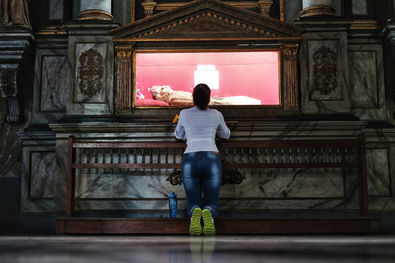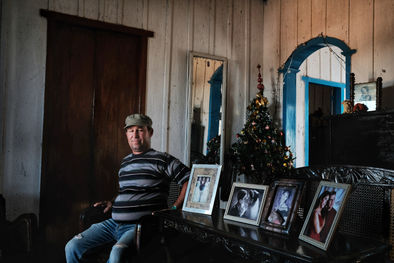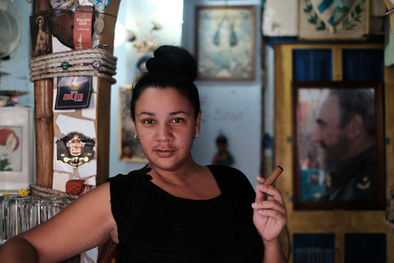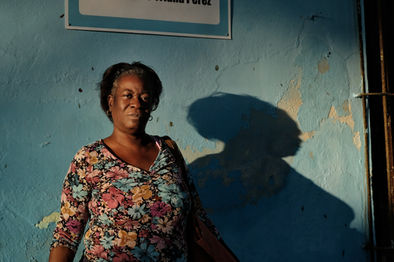FOTOTECA SIRACUSANA
PHOTOGALLERY - FOTOGRAFIA VINTAGE - BIBLIOTECA TEMATICA - CAMERA OSCURA B&W - DIDATTICA
SCRIPTPHOTOGRAPHY
Giuseppe PITINO (IT)

GIUSEPPE PITINO
Cuba non è solo un isola. Cuba è la metafora dell’impossibile che diventa realtà, sogno e un incubo allo stesso tempo. Cuba è una figura romantica, è l’ultimo baluardo galleggiante di un socialismo disperso con la caduta del muro di Berlino, un incubo che continua ad agitare il sonno dell’Occidente. Cuba si ama, Cuba si odia. Ha detto Fidel che “gli Americani non capiscono che la nostra nazione si estende ben oltre Cuba per raggiungere tutta l’umanità” e da quel giorno il sonno dell’America non è più stato lo stesso, disturbato da quel vicino festante a così poche miglia da casa. Cuba è odore di sigari, è il sapore del rum, della musica incessante e di ragazze dagli occhi splendenti come le notti del Caribe. Cuba è una storia che non ha ancora terminato il suo racconto. E infatti non c’è fotografo che non si sia misurato con l’incandescenza dei suoi colori, con la sua torrida atmosfera o che non abbia voluto raccontare i suoi giorni attraverso la fierezza degli occhi, nei volti, nei corpi colorati dei cubani. Mc Curry, Webb, Arnold, Harvey – per citare solo i più famosi fotografi che ci hanno consegnato una Cuba coloratissima – e un esercito di volenterosi fotoamatori, hanno concorso alla formazione di una koinè che scrosciante come il tempestio d’un temporale tropicale ha dilagato fino a imporsi come un codice visuale capace di determinarne la narrazione visiva. C’è dunque spazio per raccontare ancora qualcosa di Cuba? Sì, perché Cuba ha tanti lati da diventare una sfera. Giuseppe Pitino è un fotoamatore molto attento. Ha negli occhi le lezioni dei maestri, ne ha assorbito gli assunti fondamentali e sebbene il suo linguaggio lo imparenti più con il lavoro di Fulvio Bugani – il dialogo a distanza tra i due è sorprendente – Pitino aggiunge qualcosa, diremmo un particolare entusiasmo, che lo distanzia dai dilettanti unito a una costanza tipica dei professionisti. Ha detto un famoso fotografo: “I dilettanti attendono l’ispirazione. I veri professionisti si alzano e vanno a lavorare”. Così, pur riconoscendosi apprendista in un mestiere dove non si diventa mai maestri, Giuseppe Pitino vola a Cuba. E scatta. E scatta in un particolare momento della vita di Cuba, un periodo di transizione dal quale possono emergere feroci contraddizioni.
Il castrismo è alle corde, Fidel Castro prima di morire lascia la sua eredità politica a favore del fratello Raúl che a sua volta, terminato il mandato presidenziale, passerà il testimone a una nuova generazione di politici. Le pur timide “aperture” al mondo Occidentale non convincono, i cubani restano scettici. Si respira un’aria di sospensione. La biologia stava per porre fine a un capitolo della storia ma al posto di persone con bandiere nelle piazze, giovani entusiasti, si percepisce solo stanchezza a Cuba. È questo l’atteggiamento di milioni di persone con l’entusiasmo rachitico dopo una lunga attesa. Il lavoro di Giuseppe Pitino, “Cuba sospesa”, del 2017, racconta questo clima d’attesa, una sospensione tra il vecchio, romantico e rassicurante e il nuovo colmo di incognite. Pitino indaga, osserva, riporta. Lo stile di “Cuba sospesa” è anch’esso sospeso tra la “street” tradizionale e il reportage, una felice commistione dalla quale apprendiamo come l’intimità domestica sia violabile per stessa concessione dei residenti e dalle cui abitazioni, povere talvolta, altre dignitosissime, veniamo a conoscenza di una dignità che risuona in ogni dove. Così dai volti rugosi dei non più giovanissimi all’intemerata freschezza dei giovani, dall’improvvisato trombonista alla sovrabbondante e dignitosa presenza di suppellettili sappiamo che Cuba somiglia ai suoi abitanti. Anzi, Cuba è i suoi abitanti. “Cuba sospesa” è un buon documento, al pari di ogni lavoro che mostri un risvolto creduto conosciuto ma che rivela invece l’insolito tralasciato, l’insospettabile, una sintesi. E d’una sintesi occorre parlare a proposito di “Cuba sospesa”, di un filo cioè che lega insieme le immagini in un modo assoluto perché il largo affresco si completi nella descrizione. Osservate infatti la fotografia – la sola in cui è assente un soggetto “fisico”. Un muro rosa d’una scuola che è più d’un semplice muro. Le fotografie che vi sono appese, legate insieme da una fitta rete di fili, raffigurano Fidel Castro. Tutte. Quel muro è un sacrario, sopra vi è scritta per immagini l’intera storia di Cuba attraverso il suo principale protagonista.
Qui sta l’abilità di Pitino, nella sintesi. Non ci sono deroghe, sa cosa raccontare e ce lo offre alla nostra visione. Tutto si dipana sotto gli occhi dell’osservatore e noi, osservando le foto non possiamo non notare come lo stesso clima “sospeso” è tenuto a debita distanza dall’emergere del carattere dei cubani che vediamo continuare a continuare, a ruminare allegria, a continuare nelle loro tradizioni. Le strade, le chiese, gli ambienti domestici, le attività dell’uomo si rivalutano ancora nel felice sincretismo che irrora e anima il carattere dei cubani, nell’improvvisata gestione della vita. Pitino ci mostra una Cuba intima, personale, notturna e solare piena di episodi di vita che noi non manchiamo di sottolineare come contraddizioni – ma esiste un luogo con più contraddizioni di Cuba? – e con la delicatezza che gli riconosciamo. Il suo obiettivo non è destare meraviglia (santa Veronica ci salvi dai fotoamatori che intendono meravigliarci!) ma tessere un racconto verosimile, il passaggio di una fase storica e raccontarlo senza giudicare, lasciando a noi questo compito perché, come si è sempre detto, la fotografia è il territorio delle opinioni. Ma se in “Cuba sospesa” avvertiamo la misura di chi sa raccontare occorre dire che talune scelte compositive, che noi salutiamo come benvenute, mostrano un sicuro coraggio, come se il fotografo avesse sentito l’urgenza di porre l’accento sul suo stesso lavoro o, se preferite, l’apposizione di una esclamazione che risiede proprio nell’espressionismo cromatico delle fotografie o nei “tagli” ai soggetti, come se Pitino avesse preferito il suggerimento alla dichiarazione, affidando al dettaglio il complessivo potere narrativo. Qui Giuseppe Pitino mostra personalità. La sua. E noi non possiamo che prendere atto che “Cuba sospesa” è un ottimo lavoro. Una voce benvenuta, netta come i suoi colori.
Giuseppe Cicozzetti
da “Cuba sospesa”
foto Giuseppe Pitino
Cuba isn’t just an island. Cuba is the metaphor of the impossible that becomes reality, dream and a nightmare at the same time. Cuba is a romantic figure, it’s the last floating bulwark of a lost socialism with the fall of the Berlin Wall, a nightmare that continues to stir the sleep of the West.
Cuba is loved, Cuba is hated itself. Fidel said that "Americans don’t understand that our nation extends far beyond Cuba to reach all of humanity" and from that day on, America's sleep was no longer the same, disturbed by that happy neighbor so few miles away from home.
Cuba is the smell of cigars, it’s the taste of rum, of incessant music and of girls with shining eyes like the nights of the Caribbean. Cuba is a story that has not yet finished its story. And in fact there is no photographer who has not measured himself with the glow of his colors, with his torrid atmosphere or who has not wanted to tell his days through the pride of his eyes, in the faces, in the colored bodies of the Cubans.
Mc Curry, Webb, Arnold, Harvey - to quote only the most famous photographers who gave us a colorful Cuba - and an army of willing photographers, have contributed to the formation of a koinè that thunders as the storm of a tropical storm has spread up to establish itself as a visual code able of determining its visual narration. So there is space to tell something more about Cuba? Yes, because Cuba has so many sides that it becomes a sphere.
Giuseppe Pitino is a very attentive photoamateur. He has the lessons of the teachers in his eyes, he has absorbed the fundamental assumptions and although his language learns it more with the work of Fulvio Bugani - the distance dialogue between the two is surprising - Pitino adds something, we would say a particular enthusiasm, that distances from amateurs combined with a constancy typical of professionals.
A famous photographer said: "Amateurs await inspiration. Real professionals get up and go to work ". So, even though he recognizes himself as an apprentice in a profession where he never becomes a teacher, Giuseppe Pitino flies to Cuba. And he shoots. And he shoots at a particular moment in the life of Cuba, a period of transition from which fierce contradictions can emerge.
Castrism is at its end, Fidel Castro leaves his political legacy in favor of his brother Raúl, who in turn, after the presidential term, will pass the baton to a new generation of politicians. Even timid "openings" to the Western world don’t convince, the Cubans remain skeptical. There’s an air of suspension.
Biology was about to put an end to a chapter in history, but instead of people with flags in the streets, young enthusiasts, only fatigue is perceived in Cuba. This is the attitude of millions of people with rachitic enthusiasm after a long wait.
The Giuseppe Pitino’s work, "Suspended Cuba", in 2017, tells of this atmosphere of expectation, a suspension between the old, romantic and reassuring and the new height of unknowns. Pitino investigates, observes, reports. The style of "suspended Cuba" is also suspended between the traditional "street" and the reportage, a happy blend from which we learn how domestic intimacy is violated by the same concession of the residents and from whose houses, sometimes poor, other very dignified, we learn of a dignity that resounds everywhere.
So from the wrinkled faces of the no longer young to the unspeakable freshness of the young, from the improvised trombonist to the overabundant and dignified presence of furnishings we know that Cuba resembles its inhabitants. Indeed, Cuba is its inhabitants. "Suspended Cuba" is a good document, like any work that shows a known believed implication but reveals instead the unusual neglected, the unsuspectable, a synthesis.
And of a synthesis we must speak about "Suspended Cuba", a thread that links the images together in an absolute way because the large fresco is completed in the description. In fact, observe the photograph - the only one in which a "physical" subject is absent. A pink wall of a school that is more than a simple wall. The photographs hanging there, tied together by a dense network of wires, depict Fidel Castro. All. That wall is a shrine, above is written in images of the entire history of Cuba through its main protagonist.
Here is Pitino's ability, in the synthesis. There are no exceptions, knows what to tell and offers us to our vision. Everything unfolds under the eyes of the observer and we, observing the photos, we can not fail to notice that the same "suspended" climate is kept at a safe distance from the emergence of the Cuban character that we see’m keep on’keepin’on, to ruminate joy, to continue in their traditions.
The streets, the churches, the domestic environments, the activities of man are still re-evaluated in the happy syncretism that inspires and animates the character of the Cubans, in the improvised management of life. Pitino shows us an intimate, personal, nocturnal and sunny Cuba full of episodes of life that we don’t miss to underline as contradictions - but is there a place with more contradictions than Cuba? - and with the delicacy we recognize him.
His goal is not arouse wonder (saint Veronica save us from amateur photoamatuers who want to surprise us!) But weaving a plausible story, the passage of a historical phase and telling it without judging, leaving us this task because, as we have always said, the photography is the territory of opinions.
But if in "suspended Cuba" we feel the measure of who knows how to tell a story, we must say that certain compositional choices, which we greet as welcome, show a sure courage, as if the photographer had felt the urgency to put the accent on his own work or, if you prefer, the affixing of an exclamation that resides precisely in the chromatic expressionism of the photographs or in the "cuts" to the subjects, as if Pitino had preferred the suggestion to the statement, entrusting the overall narrative power to detail. Here Giuseppe Pitino shows personality. His own. And we can only take note that "Suspended Cuba" is a great job. A welcome voice, as clear as its colors.
Giuseppe Cicozzetti
from “Suspended Cuba”
ph. Giuseppe Pitino

















